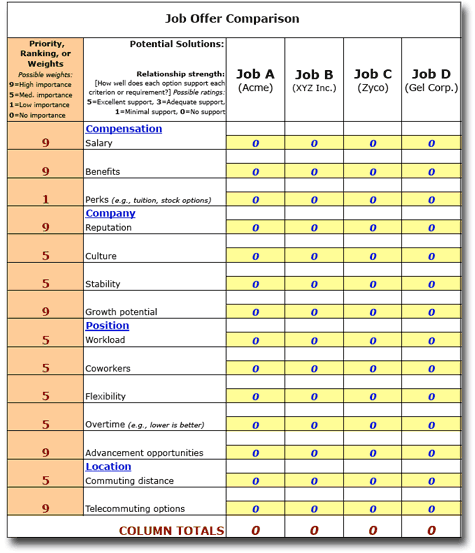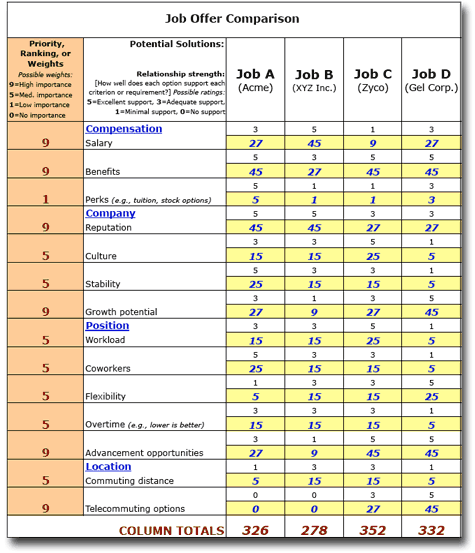Make Tough Decisions Easily with This Handy Tool
by Adele Sommers
Decisions, decisions, decisions! How do we ever manage to make them? If you think about how haphazardly or emotionally we resolve to do things at times, it's somewhat surprising when we actually succeed.
 That's why I'm going to share with you an outstanding decision-making technique I've used for years. Clients have told me it's changed their lives! It can help you stop arguing with yourself or others about the decisions that you or your organization might be agonizing over today. What is your peace of mind worth? That's why I'm going to share with you an outstanding decision-making technique I've used for years. Clients have told me it's changed their lives! It can help you stop arguing with yourself or others about the decisions that you or your organization might be agonizing over today. What is your peace of mind worth?
Have you ever struggled to pinpoint the best solution to a problem, decide among business ventures or product designs, choose between two or more schools or job offers, select the best candidate to hire, or figure out where to go on holiday? I'm sure you've encountered many situations in which you would have welcomed extra help with making decisions.
Therefore, imagine being able to make difficult choices relatively quickly, reliably, and realistically. This technique works for situations as varied as personal issues, team problem solving, engineering, or strategic planning, primarily when several solutions or alternatives could apply. When used in a group setting, it has insightful, consensus-building effects.
 The "Swiss Army Knife" of Thinking Tools The "Swiss Army Knife" of Thinking Tools
This technique boasts about as many uses as a Swiss army knife. Often referred to as a "prioritization matrix" or "weighted scoring method," it goes by several different names and has numerous variations.
I'll tell you right up front that there's some arithmetic involved. But you certainly don't have to be a math whiz to master it. If you can use either a calculator or a spreadsheet, you can easily use this method.
Ready to try it? OK, let's get started.
When using this technique, you will be identifying values, requirements, or criteria that are important to you (or to whomever the stakeholders are) for the decision to be made. How does it work?
Let's Look at Some Basic Examples
 Example 1: Imagine that you've received multiple job offers, and all of the offers have pros and cons, making your selection really tough. Example 1: Imagine that you've received multiple job offers, and all of the offers have pros and cons, making your selection really tough.
You could start by thinking about your values in terms of categories of "job success criteria," such as:
- Compensation (salary, benefits, perks)
- Company (reputation, culture, stability, growth potential)
- Position (workload, coworkers, flexibility, overtime, advancement)
- Location (commuting distance, telecommuting options)
Example 2: To select among different vacation destinations, your value categories might include the following (choose your own specific "vacation success criteria"):
- Overall expense
- Climatic conditions
- Transportation options
- Distance and travel time
- Comfort of accommodations
- Range of recreational activities
Example 3: To decide which business venture to pursue, your value categories might include the following (choose your own specific "business success criteria"):
- Alignment with passions and strengths
- Startup or acquisition requirements
- Potential for return on investment
- Control over working parameters
- Traits of potential collaborators
- Quality-of-life considerations
- Exit options or alternatives
Have you noticed that the categories and criteria are fairly neutral? That's because only you (or your team) can decide just how important each criterion is. You can assign each one a measure of importance by giving it a priority, ranking, or weight.
For instance, to weight your criteria, you can use numbers. Higher numbers indicate more importance or a higher priority. Lower numbers indicate less importance or a lower priority. You could use any range you wish, such as: High importance=9, medium importance=5, low importance=1, no importance=0.
Here's a More Detailed Illustration
So, let's take our example of choosing among job offers to illustrate this technique. After assigning weights, priorities, or ranks to the criteria, the next step is to list the criteria and their measures down the left side of a spreadsheet.
Next, list the job offers (or vacation spots, business ventures, etc.) in the columns across the top. That way, you can begin using the criteria on the left to evaluate the different options. Our job offer example might look something like this:

Scoring the options will involve another set of ratings to show how well each option listed at the top supports each criterion on the left. If salary (one of your criteria) is very important, how well does Job A support it? Ultimately, you will rate the salaries for all of the job offers, and also rate all of the other criteria. Devise a rating scale to use for all scoring, such as: Excellent support=5, acceptable support=3, minimal support=1, no support=0.
Once you enter your rating numbers in the spaces provided in each column, you (or your spreadsheet) can multiply each rating number by its corresponding weighted criterion. As you finish scoring the criteria for all options, you or the spreadsheet can sum the results and display the grand totals at the bottom:

As shown above, you can finally see how your options compare with one another based on your criteria, where the highest-scoring options represent your best choices.
Notice that Job B had the highest salary score, but the lowest grand total; Job C had the lowest salary score, yet the highest grand total! This can happen when you allow all of your values to have a "voice" in the process.
A Few Additional Tips…
 This process essentially translates your values into a scoring tool. The final results might reinforce your gut feelings about heading in a certain direction, or could surprise you with new insights or an unexpected outcome. If something seems really amiss, however, try adjusting the weights or ratings until they more accurately reflect results that appear reasonable to you and your team. This process essentially translates your values into a scoring tool. The final results might reinforce your gut feelings about heading in a certain direction, or could surprise you with new insights or an unexpected outcome. If something seems really amiss, however, try adjusting the weights or ratings until they more accurately reflect results that appear reasonable to you and your team.
- Be aware that the goal is not to strive for pinpoint accuracy using these numbers. Rather, you're trying to accentuate or even exaggerate the contrasts among the options, to better reveal how different they are and identify those most aligned with your values.
In conclusion, this technique has served its purpose if you feel at peace with your final decision. Since we often base decisions on incomplete information, however, it always helps to have a fallback plan just in case circumstances change or a selection doesn't work out as hoped. In that case, consider pursuing the next-highest-scoring alternatives, since you've already weighed their merits as part of this exercise.
Copyright 2007 Adele Sommers
|


